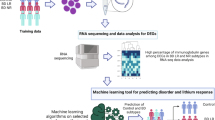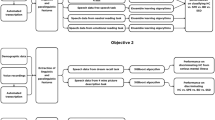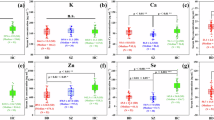Abstract
We have previously reported the altered expressions of HSPF1 and LIM in the lymphoblastoid cell lines (LCLs) derived from Japanese patients with bipolar disorder (bipolar I disorder). The altered expression at the LCL level would be useful for developing diagnostic markers as well as a cellular model for bipolar disorder. In this study, we extended our previous study by measuring their expressions using the following samples: (1) larger number of LCLs from Japanese subjects, (2) LCLs from Caucasian subjects, and (3) LCLs from patients with bipolar II disorder or schizophrenia. We confirmed the increased expression of HSPF1 (P=0.009) and decreased expression of LIM (P=0.001) in the LCLs from patients with Japanese bipolar I disorder. These altered expressions were also observed in those from patients with Japanese bipolar II disorder (P=0.002 for HSPF1 and P=0.072 for LIM). We also found the altered expressions of HSPF1 in LCLs from Caucasian patients with bipolar II disorder (P=0.011) and LIM in those from patients with schizophrenia (P=0.001).
Similar content being viewed by others
Log in or create a free account to read this content
Gain free access to this article, as well as selected content from this journal and more on nature.com
or
References
Berk M, Kirchmann NH, Butkow N (1996) Lithium blocks 45Ca2+ uptake into platelets in bipolar affective disorder and controls. Clin Neuropharmacol 19:48–51
Cheung VG, Conlin LK, Weber TM, Arcaro M, Jen KY, Morley M, Spielman RS (2003) Natural variation in human gene expression assessed in lymphoblastoid cells. Nat Genet 33:422–425
Dubovsky SL, Christiano J, Daniell LC, Franks RD, Murphy J, Adler L, Baker N, Harris RA (1989) Increased platelet intracellular calcium concentration in patients with bipolar affective disorders. Arch Gen Psychiatry 46:632–638
Eckert A, Gann H, Riemann D, Aldenhoff J, Muller WE (1994) Platelet and lymphocyte free intracellular calcium in affective disorders. Eur Arch Psychiatry Clin Neurosci 243:235–239
Emamghoreishi M, Schlichter L, Li PP, Parikh S, Sen J, Kamble A, Warsh JJ (1997) High intracellular calcium concentrations in transformed lymphoblasts from subjects with bipolar I disorder. Am J Psychiatry 154:976–982
Emamghoreishi M, Li PP, Schlichter L, Parikh SV, Cooke R, Warsh JJ (2000) Associated disturbances in calcium homeostasis and G protein-mediated cAMP signaling in bipolar I disorder. Biol Psychiatry 48:665–673
Fewell SW, Travers KJ, Weissman JS, Brodsky JL (2001) The action of molecular chaperones in the early secretory pathway. Annu Rev Genet 35:149–191
Gershon ES, Cloninger CR (1994) Genetic approaches to mental disorders. American Psychiatric, Washington, DC
Goodwin FK, Jamison KR (1990) Manic-Depressive illness. Oxford University, New York
Gruska S, Ihrke R, Stolper S, Kraatz G, Siffert W (1997) Prevalence of increased intracellular signal transduction in immortalized lymphoblasts from patients with essential hypertension and normotensive subjects. J Hypertens 15:29–33
Hough C, Lu SJ, Davis CL, Chuang DM, Post RM (1999) Elevated basal and thapsigargin-stimulated intracellular calcium of platelets and lymphocytes from bipolar affective disorder patients measured by a fluorometric microassay. Biol Psychiatry 46:247–255
Iwamoto K, Kakiuchi C, Bundo M, Ikeda K, Kato T (2004) Molecular characterization of bipolar disorder by comparing gene expression profiles of postmortem brains of major mental disorders. Mol Psychiatry 9:406–416
Kakiuchi C, Iwamoto K, Ishiwata M, Bundo M, Kasahara T, Kusumi I, Tsujita T, Okazaki Y, Nanko S, Kunugi H, Sasaki T, Kato T (2003) Impaired feedback regulation of XBP1 as a genetic risk factor for bipolar disorder. Nat Genet 35:171–175
Kato T (2001a) Molecular genetics of bipolar disorder. Neurosci Res 40:105–113
Kato T (2001b) The other, forgotten genome: mitochondrial DNA and mental disorders. Mol Psychiatry 6:625–633
Kato T, Ishiwata M, Nagai T (2002) Mitochondrial calcium response in human transformed lymphoblastoid cells. Life Sci 71:581–590
Kato T, Ishiwata M, Mori K, Washizuka S, Tajima O, Akiyama T, Kato N (2003) Mechanisms of altered Ca2+ signalling in transformed lymphoblastoid cells from patients with bipolar disorder. Int J Neuropsychopharmacol 6:379–389
Kusumi I, Koyama T, Yamashita I (1992) Thrombin-induced platelet calcium mobilization is enhanced in bipolar disorders. Biol Psychiatry 32:731–734
Lidow MS (2003) Calcium signaling dysfunction in schizophrenia: a unifying approach. Brain Res Brain Res Rev 43:70–84
Maeno-Hikichi Y, Chang S, Matsumura K, Lai M, Lin H, Nakagawa N, Kuroda S, Zhang JF (2003) A PKC epsilon-ENH-channel complex specifically modulates N-type Ca2+ channels. Nat Neurosci 6:468–475
Manji HK, Potter WZ (1997) Monoaminergic systems. Dekker, New York
Mathews CA, Reus VI (2001) Assortative mating in the affective disorders: a systematic review and meta-analysis. Compr Psychiatry 42:257–262
Mirnics K, Middleton FA, Lewis DA, Levitt P (2001) Analysis of complex brain disorders with gene expression microarrays schizophrenia as a disease of the synapse. Trends Neurosci 24:479–486
Okamoto Y, Kagaya A, Shinno H, Motohashi N, Yamawaki S (1995) Serotonin-induced platelet calcium mobilization is enhanced in mania. Life Sci 56:327–332
Panov A, Obertone T, Bennett-Desmelik J, Greenamyre JT (1999) Ca(2+)-dependent permeability transition and complex I activity in lymphoblast mitochondria from normal individuals and patients with Huntington’s or Alzheimer’s disease. Ann NY Acad Sci 893:365–368
Pietruck F, Spleiter S, Daul A, Philipp T, Derwahl M, Schatz H, Siffert W (1998) Enhanced G protein activation in IDDM patients with diabetic nephropathy. Diabetologia 41:94–100
Washizuka S, Kakiuchi C, Mori K, Kunugi H, Tajima O, Akiyama T, Nanko S, Kato T (2003) Association of mitochondrial complex I subunit gene NDUFV2 at 18p11 with bipolar disorder. Am J Med Genet 120B:72–78
Yamawaki S, Kagaya A, Tawara Y, Inagaki M (1998) Intracellular calcium signaling systems in the pathophysiology of affective disorders. Life Sci 62:1665–1670
Yoon IS, Li PP, Siu KP, Kennedy JL, Cooke RG, Parikh SV, Warsh JJ (2001a) Altered IMPA2 gene expression and calcium homeostasis in bipolar disorder. Mol Psychiatry 6:678–683
Yoon IS, Li PP, Siu KP, Kennedy JL, Macciardi F, Cooke RG, Parikh SV, Warsh JJ (2001b) Altered TRPC7 gene expression in bipolar-I disorder. Biol Psychiatry 50:620–626
Acknowledgements
The authors thank the individuals with bipolar disorder and unaffected volunteers who participated in this study. The authors thank Mizuho Ishiwata and Mizue Kametani for their technical assistance. Data and biomaterials of the NIMH pedigrees were collected in four projects that participated in the NIMH Bipolar Disorder Genetics Initiative. From 1991 to 1998, the principal investigators and coinvestigators were: Indiana University, Indianapolis, IN, USA, U01MH46282, J. Nurnberger, M. Miller, and E. Bowman; Washington University, St Louis, MO, USA, U01 MH46280, T. Reich, A. Goate, and J. Rice; Johns Hopkins University, Baltimore, MD, USA, U01 MH46274, J. R. DePaulo Jr, S. Simpson, and C. Stine; NIMH Intramural Research Program, Clinical Neurogenetics Branch, Bethesda, MD, USA, E. Gershon, D. Kazuba, and E. Maxwell.
Author information
Authors and Affiliations
Corresponding author
Rights and permissions
About this article
Cite this article
Iwamoto, K., Bundo, M., Washizuka, S. et al. Expression of HSPF1 and LIM in the lymphoblastoid cells derived from patients with bipolar disorder and schizophrenia. J Hum Genet 49, 227–231 (2004). https://doi.org/10.1007/s10038-004-0136-5
Received:
Accepted:
Published:
Issue date:
DOI: https://doi.org/10.1007/s10038-004-0136-5
Keywords
This article is cited by
-
Immunoglobulin genes expressed in lymphoblastoid cell lines discern and predict lithium response in bipolar disorder patients
Molecular Psychiatry (2023)
-
Peripheral PDLIM5 expression in bipolar disorder and the effect of olanzapine administration
BMC Medical Genetics (2012)
-
Construction and analysis of the protein-protein interaction networks for schizophrenia, bipolar disorder, and major depression
BMC Bioinformatics (2011)
-
A computational procedure for functional characterization of potential marker genes from molecular data: Alzheimer's as a case study
BMC Medical Genomics (2011)
-
Gene expression analysis in lymphoblastoid cells as a potential biomarker of bipolar disorder
Journal of Human Genetics (2011)



